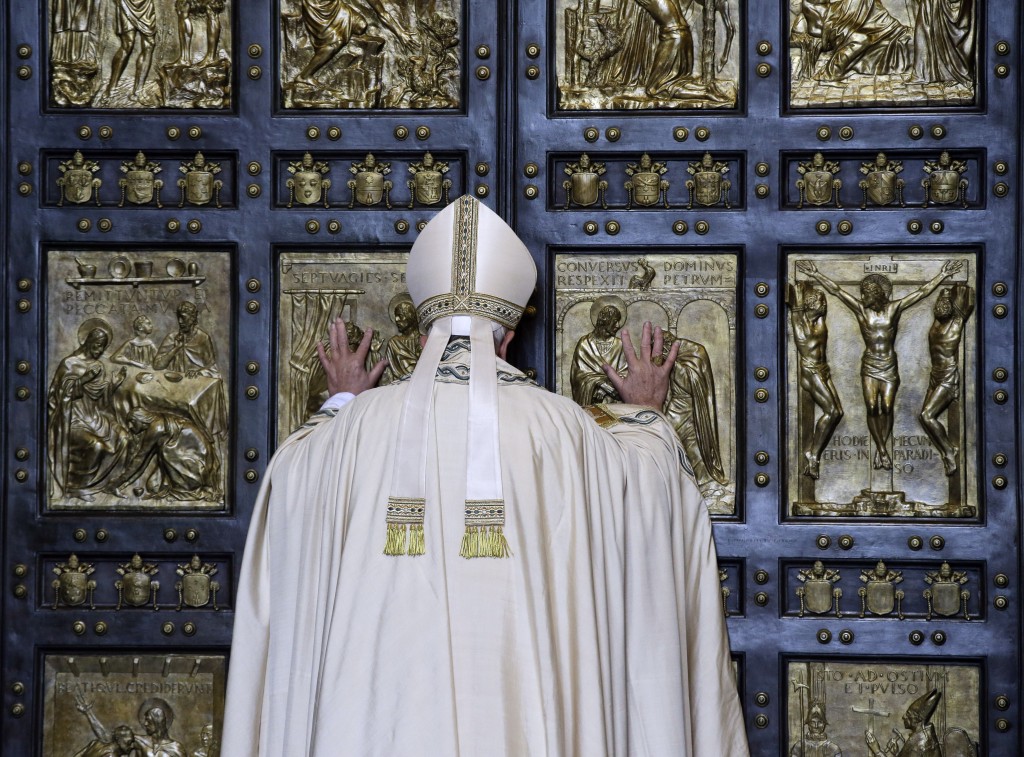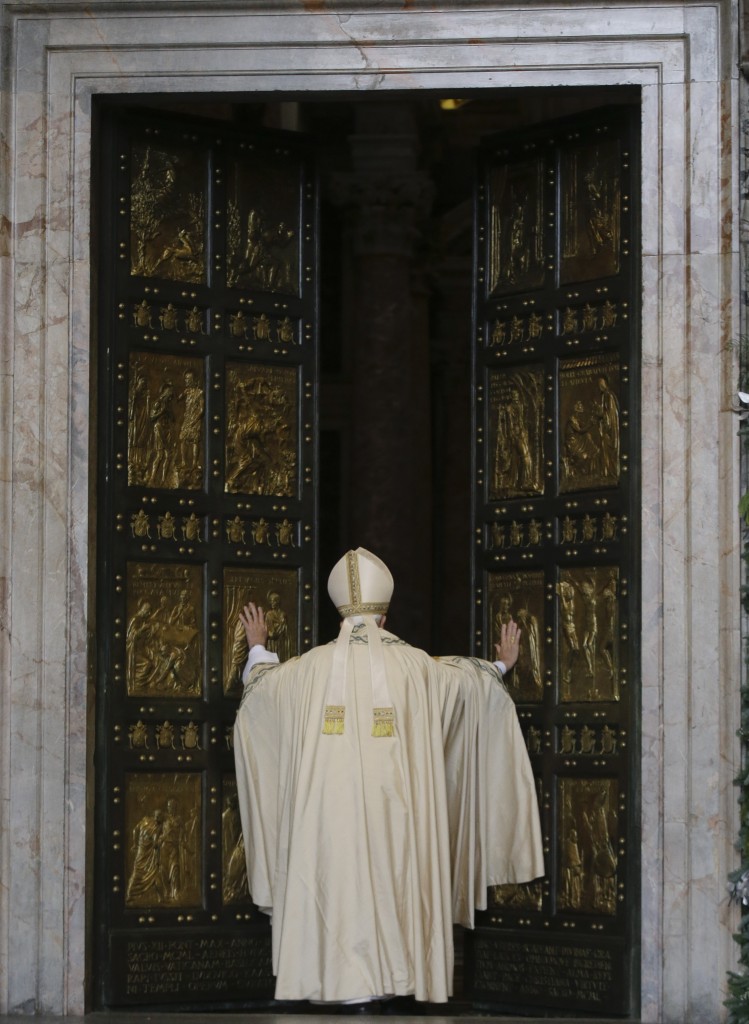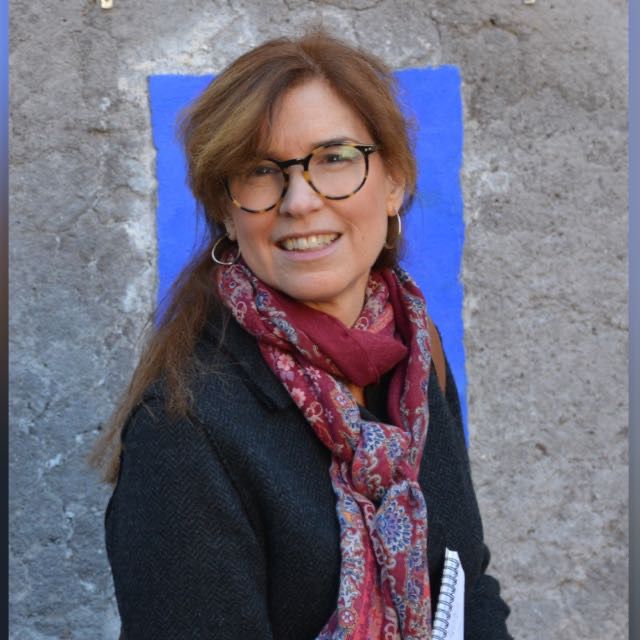
Dear Blog Readers,
Since we are all caught up in the pre-holiday frenzy and surely no one has much time to read blog posts, I will keep this one brief.
This week I covered the December 8th opening of the Jubilee Year of Mercy at the Vatican. During this event, Pope Francis pushed open the Holy Door on St. Peter’s Basilica and passed through it. My AP colleague Gregorio Borgia was in the pool of photographers who were allowed up close as the Pope opened the door, and Gregorio has kindly given me a few of his fabulous extra, unused photos. The photos used by AP were on the front page of “The International New York Times”—just to give you all an idea of how lucky my blog is to have such contributions.
Given the media drumbeat over the past few weeks warning of the potential of a IS terror attack on the Vatican, it came as no surprise that the turnout was relatively small. Official estimates said the turnout was around 50,000, and there were an extra 5,000 police and soldiers put on duty to protect pilgrims coming to the event. Police created a big security zone around the Vatican and anyone entering the area had to open their bags for searching, unzip their jackets and be frisked by hand-held metal detectors. People entering St. Peter’s Square then went through regular airport-style metal detectors.
Interestingly, during the ceremony for the opening of the Holy Door in the 2000 jubilee year, AP Television relied on Vatican TV coverage and did not send a crew. Despite the fact that the Vatican TV had a total of 19 cameras dedicated to their live coverage of this week’s event, we still provided our own. This time there were nine of us from AP Television covering the event. We had a team on overnight to film pilgrims arriving and prayer vigils. I started at 6am with a cameraman to get pilgrims arriving in St. Peter’s Square. We actually had much less to do than we expected given the low turnout.

Background:
For those readers who are not familiar with the Catholic tradition of Jubilee Years, it began under Pope Boniface VII in 1300. The idea was for pilgrims to travel on foot to Rome, pass through the doors of the great basilicas and for doing that (combined with confession, communion, renunciation of sin, prayer for the Pope, and charitable works) the church would grant an “indulgence” for the forgiveness of their sins. (More on the Indulgences below). The original idea was to have a Jubilee year every 100 years.
According to the Vatican, among the famous participants in that first Catholic Jubilee year were: Dante, Giotto and Charles de Valois, brother of the King of France.
Later Popes increased the frequency of what has become known as “ordinary” Jubilee years to every 25 years. But there are also “extraordinary” jubilee years. Pope Francis’ “Jubilee of Mercy” is the 65th “extraordinary” jubilee in the history of the Catholic Church.
Pope Francis has decided to expand the doors and indulgence concept to include Holy Doors in Catholic churches around the globe. He opened the first “Holy Door” at the Cathedral in Bangui in the Central African Republic on his visit there in November.
In a letter written on September 1st, Pope Francis outlined how the church would grant indulgences during the extraordinary jubilee year. He specifically reached out to prison inmates and women who have undergone abortions. Here are some excerpts from his letter.
For the Catholic Faithful:
“To experience and obtain the Indulgence, the faithful are called to make a brief pilgrimage to the Holy Door, open in every Cathedral or in the churches designated by the Diocesan Bishop, and in the four Papal Basilicas in Rome, as a sign of the deep desire for true conversion.”
For prisoners:
“My thoughts also turn to those incarcerated, whose freedom is limited. The Jubilee Year has always constituted an opportunity for great amnesty, which is intended to include the many people who, despite deserving punishment, have become conscious of the injustice they worked and sincerely wish to re-enter society and make their honest contribution to it. May they all be touched in a tangible way by the mercy of the Father who wants to be close to those who have the greatest need of his forgiveness. They may obtain the Indulgence in the chapels of the prisons.”
For Women who have had an abortion:
“The tragedy of abortion is experienced by some with a superficial awareness, as if not realizing the extreme harm that such an act entails. Many others, on the other hand, although experiencing this moment as a defeat, believe they have no other option. I think in particular of all the women who have resorted to abortion. I am well aware of the pressure that has led them to this decision. I know that it is an existential and moral ordeal. I have met so many women who bear in their heart the scar of this agonizing and painful decision. What has happened is profoundly unjust; yet only understanding the truth of it can enable one not to lose hope. The forgiveness of God cannot be denied to one who has repented, especially when that person approaches the Sacrament of Confession with a sincere heart in order to obtain reconciliation with the Father. For this reason too, I have decided, notwithstanding anything to the contrary, to concede to all priests for the Jubilee Year the discretion to absolve of the sin of abortion those who have procured it and who, with contrite heart, seek forgiveness for it.”
Of course Catholic Church “indulgences” have a bad reputation harking back to the Middle Ages when they were sold.
Martin Luther, the friar who kicked off the Reformation with his famous 95 theses, dedicated many of them to the question of indulgences being sold by the Church. And perhaps the historic cloud that hangs over the word indulgences somehow prompted the ire of the piqued prelate in my earlier post (Questioning Indulgences with a Piqued Prelate).

Thanks for this post, and for the beautiful photos. I love the expansion of the Holy Doors to be all over the world, an essential theological concept: that Christ is born, and dies, in every corner of the earth, and in every age. And, wherever these births and deaths happen, that is the true center of the world. “Meister Eckart said, We are all called to be mothers of God, for God is always waiting to be born.” Another cheer to Pope Francis, for expanding this concept to Jubilee, and to the doors that open it.
Jubilee Years are in the Old Testament as an instruction from God for early Israel, every 25 years to have a year of jubilees, in which slaves are set free, indebtedness is forgiven, land is restored to its original owner, and justice is fulfilled between people. The Catholic practice is based on this (or is a rip-off of it, depending on your view). Jesus talked about the Jubilee year and the kingdom.
I’m with Luther on the indulgence question. Luther argued that the church could not interfere in the relationship between people and God, who alone forgives. And that millions, perhaps billions, were being made on the sale of indulgences, which at that time were for sale to anxious parents of young soldiers fighting in foreign wars. The money was used to pay Michelangelo and Titian for their work on the Vatican. Great art. Lousy theology. And spiritual violation of the laity. Luther had also noted, in his sabbatical year in Rome, priestly abuse of young boys, a forerunner of recent scandals. Great cynicism at work in all this. But not, I think, In Pope Francis.
You might be interested to note that the news here is so full of San Bernardino, and our own fears of IS, that there is not one word about Rome, not even on NPR. In fear, we draw inward. Also, we can’t take our eyes off Trump and his cohort.
Have been unusually busy, a post, for some astonishing reason, has gone somewhat viral, over 50,000 views and still climbing. It’s called No More Lying About Mary, if you are interested, though how the Mama in you is coping with Christmas and other issues, as well as working and writing posts, is beyond me. Looking forward to Christmas!
Thank you Nancy for your fascinating comment. I had heard something about the Jubilee Years in the Jewish tradition but knew nothing about it, so thanks for that fascinating information. I also appreciate your thoughts on Martin Luther — you are so knowledgeable on all this religious history and your comments are so important. The San Bernardino shooting and Trump’s inane comments are getting a lot of play in the news here too. It is so discouraging. I am going right now to read your “No Lying About Mary” post.
Beautiful pics!
Gregorio is a star!!
I guess I’m surprised by the low turn out for the opening since I had read some blog or newsletter that had emphasized the amount of security that was being set up in Rome for the Jubilee, I have also read somewhere that hotels are not being filled as much as expected. I know I was able to add two days to the start of my stay with no trouble only about 6 weeks ago. Since I have also read about the steps necessary to go through the Holy Door at St. Peter’s I know I won’t be doing that. There is too much else I want to do. Time will tell about the doors at the other major churches.
Still a bit of planning to do before I leave this week.
A presto,
Joan
Joan, if you are interested in going through the Holy Door at St. Peter’s I think you should try. My office intern signed up on line and they gave her a time and she went through quite quickly without too much security hassle.
How fascinating!!! And I loved reading about Gregorio Borgia….how many centuries have the Borgia’s been in Tuscany? My ancestors came from Siena and I’m sure they knew of or perhaps interacted with that ancient family.
Thank you Ginnie. I don’t know about the Borgia’s in Tuscany, but I know Gregorio always gets asked if he is related to the Borgia Pope of TV series fame. He says he is not because they came from Spain and he does not have Spanish origins.
I hope that holy door doesn’t hit him on his way out…
Great post – I just realized it was there.
What do you mean, set times to go through the doors? I went during the last Jubilee and we simply walked in. Are they not doing that anymore?
I think they set up a way for people to make appointments to go through because they were expecting masses of people, but in the end there are not very many people so there is no need.